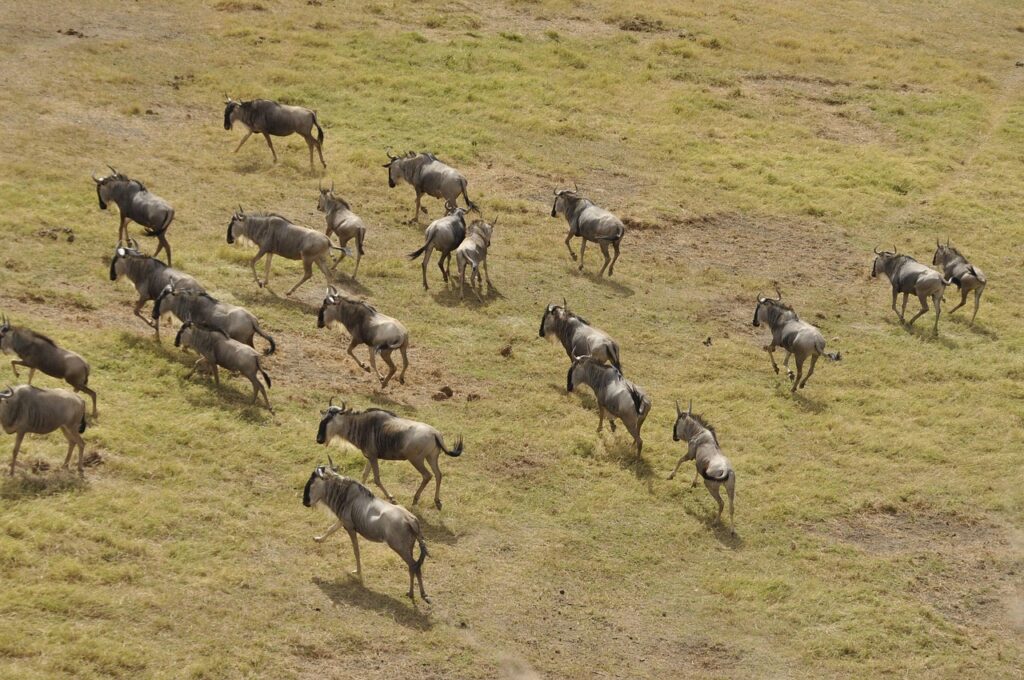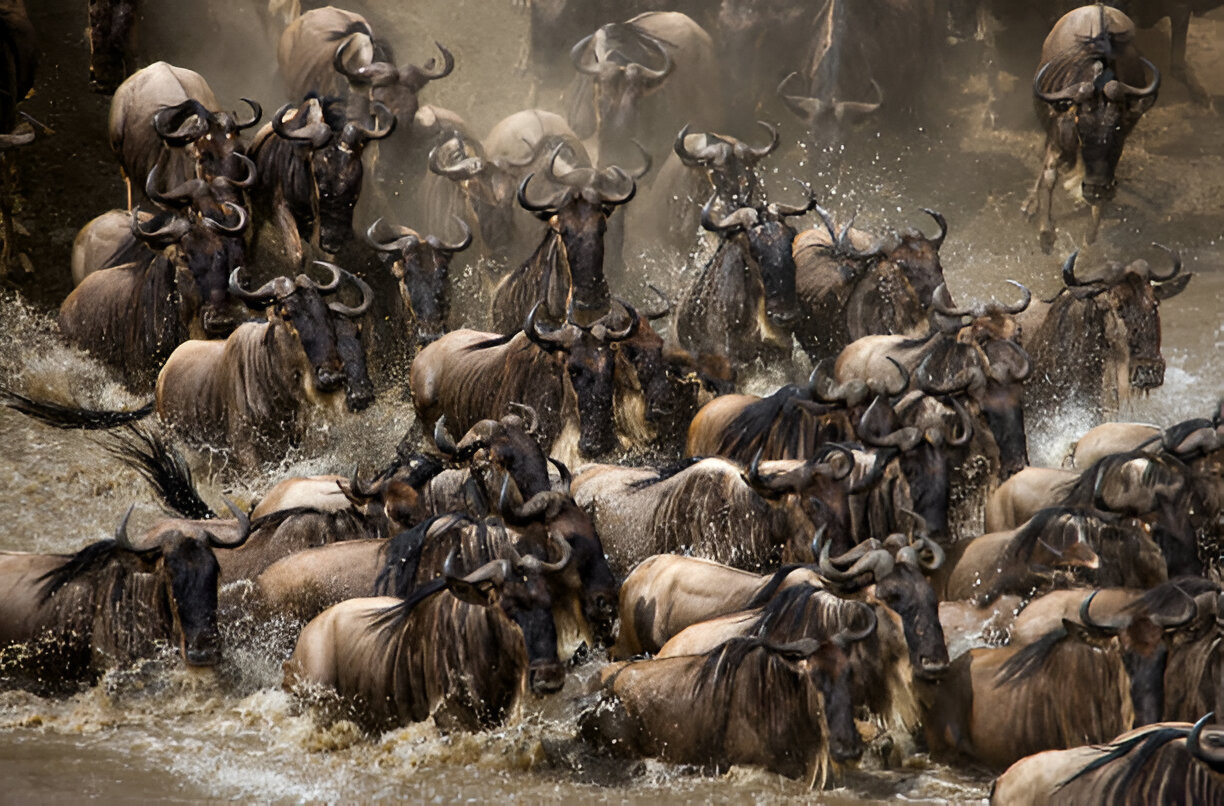
- Tanzania - East Africa
How Often Can I See the Great Migration in One Trip?
The Great Migration in Tanzania is one of the most remarkable wildlife spectacles on Earth. Every year, over 1.5 million wildebeest, accompanied by zebras and gazelles, move in a circular pattern across the Serengeti ecosystem in search of fresh grazing and water. For travelers, a common question is: “How often can I see the Great Migration in one trip?”
The answer depends on when you visit, how long you stay, and which regions of the Serengeti your safari covers. Unlike a single event, the Great Migration is a year-round cycle, which means that depending on your timing, you may witness different stages — from calving season to dramatic river crossings.
Understanding the Great Migration Cycle
To know how often you can see the Great Migration in one safari, it’s important to understand its seasonal movements:
December – March: Calving Season (Southern Serengeti & Ndutu Plains)
Wildebeest gather in the Ndutu area to give birth. Around 500,000 calves are born in just a few weeks.
Predator activity is high — lions, cheetahs, and hyenas take advantage of vulnerable newborns.
If your trip is during this season, you will see daily action as herds spread across the plains.
April – May: Long Rains (Central Serengeti)
Herds start moving northward through the central Serengeti.
You’ll see vast columns of wildebeest stretching across the savannah, often lasting for hours as they move.
June – July: Grumeti River Crossings (Western Serengeti)
One of the most dramatic phases — wildebeest cross the Grumeti River, facing crocodile-filled waters.
If your safari covers this region, you may see multiple river crossing attempts in a single week.
July – October: Mara River Crossings (Northern Serengeti)
The most famous stage of the migration.
Thousands of wildebeest leap into the Mara River, many perishing while others make it to Kenya’s Maasai Mara.
During this period, if you stay for 4–7 days, you might witness several river crossings as herds cross back and forth.
November: Short Rains (Return South)
The herds start heading back south to the Serengeti from Kenya.
You’ll see migrating columns on the move, though crossings are fewer.
How Often Can You See the Great Migration in One Trip?
The frequency of sightings depends on three factors:
1. Length of Your Safari
On a 3–4 day safari, you might see one or two major events — for example, a calving spectacle or a river crossing.
On a 7–10 day safari, your chances increase dramatically. You may witness multiple stages — herds grazing, predators hunting, and possibly several crossings.
2. Safari Location and Coverage
If you focus on one park region, you’ll see the migration activity specific to that time.
If your itinerary covers multiple parts of the Serengeti (south, central, west, north), you can see different stages of the migration in a single trip. For example:
Start in Ndutu for calving.
Move to central Serengeti for massive herds on the march.
End in northern Serengeti for Mara River crossings.
3. Season of Travel
During peak migration seasons (calving in Ndutu or Mara crossings in July–October), you may see migration daily.
In transitional months (April, May, November), sightings are more spread out — but you still experience huge herds on the move.
Chat with our expert direct via email!
Practical Safari Itineraries for Maximum Great Migration Sightings
If you’re asking “How often can I see the Great Migration in one trip?”, consider the following safari styles:
✅ Short Safari (3–4 Days)
Focus on one migration hotspot.
Example: 4 days in northern Serengeti during July–August.
Chances: 1–2 major migration events.
✅ Standard Safari (6–7 Days)
Combine two Serengeti regions.
Example: 3 nights in central Serengeti, 3 nights in northern Serengeti.
Chances: multiple herds, possible predator hunts, and river crossings.
✅ Extended Safari (10+ Days)
Cover all key migration areas — southern, central, western, and northern Serengeti.
Chances: several migration spectacles in one trip — calving, mass movements, and river crossings.
How Guides Increase Your Chances
Safari guides play a huge role in maximizing Great Migration sightings. Professional guides:
Track herd movements daily.
Know alternative routes to reach migration hotspots.
Communicate with other guides to locate where herds or river crossings are happening.
This means that even within a short safari, a skilled guide can help you see the migration multiple times.
Is It Guaranteed to See the Great Migration?
Many travelers wonder: “Can I guarantee seeing the Great Migration multiple times in one trip?”
Yes, if you visit during peak months (Jan–March or July–October) and spend at least 5–7 days in the Serengeti.
No guarantee in transitional months, but you will still see large resident herds and other wildlife.
Remember, the migration is nature-driven — timing can shift slightly each year based on rainfall patterns.
Other Wildlife You’ll See Alongside the Migration
Even if you miss a river crossing on a certain day, you’ll still experience incredible wildlife:
Big Cats: lions, cheetahs, leopards.
Elephants and giraffes.
Crocodiles and hippos in rivers.
Birdlife — eagles, vultures, and flamingos in some regions.
This means every day of your safari still offers remarkable game viewing beyond just wildebeest.
Tips to Maximize Migration Sightings
Travel in Peak Months – Calving (Jan–March) or River Crossings (July–Oct).
Book 6+ Days – Longer stays mean more chances to see multiple stages.
Choose Lodges in Migration Hotspots – Stay close to action (Ndutu, Grumeti, Kogatende).
Hire Expert Guides – Guides with experience track herds better.
Stay Flexible – Migration is unpredictable; be ready to change routes.
Final Answer: How Often Can You See the Great Migration in One Trip?
On a well-planned safari, you can see the Great Migration multiple times in one trip.
Short safari (3–4 days) → Expect 1–2 sightings.
Medium safari (6–7 days) → Expect 3–5 sightings, possibly more.
Extended safari (10+ days) → You may experience the migration daily, across different stages and regions.
The Great Migration in Tanzania is not a single event but a continuous cycle, meaning the longer you stay and the more regions you cover, the more often you’ll see it.
📌 Build Your Tour Today!


Olduvai Tours Tan_Africa
We ensure that your journey is not just a trip but a meaningful exploration of Tanzania’s natural and cultural treasures. Let us turn your dream safari into reality!
Booking your Adventure with Olduvai Tours Tan Africa
Olduvai Tours Tan Africa specializes in creating unforgettable Tanzania safari experiences, offering expert guides, personalized itineraries, and high-quality service.
Other Tours You May book with Olduvai Tours Tan_Africa:
Tanzania – East Africa Is It Possible to Do a Day Trip to a Park from Arusha? Arusha is…
Book 4 Days Tanzania Luxury Safari Itinerary Book Your 4 Days Luxury Safari Package! Tour Package Details 📍 Tarangire…
Affordable Group Joining Safari in Tanzania 2025 – Budget-Friendly 📍 Serengeti National Park, Ngorongoro Crater and Tarangire National Park…

